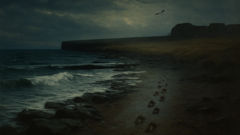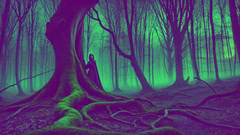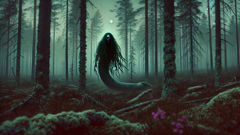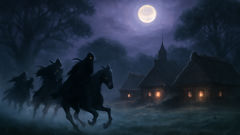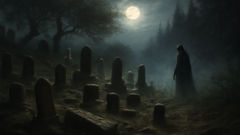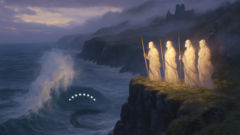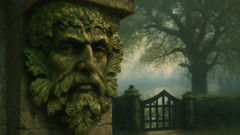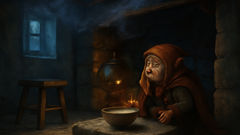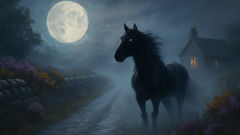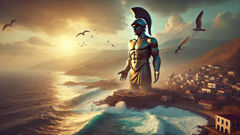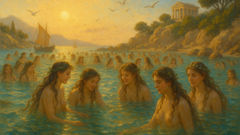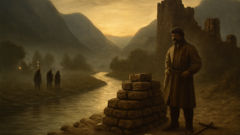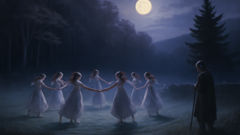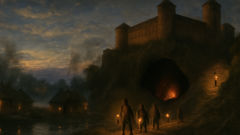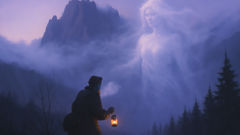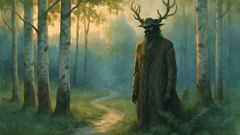Introduction
On the northern edge of the British Isles, where the Atlantic breathes cold across basalt and peat, Orkney keeps a memory that will not fully die. The archipelago’s wind-carved headlands and low, stubborn fields hold stories the sea taught them: how to read tides and sky, how to mend nets, how to plant when the weather grudgingly allows. Woven into those practical teachings is another form of knowledge—an oral cartography of dread—whose compass points to a single, loathsome name. They called it the Nuckelavee. Said to be born where storm and brackish tide meet peat and bone, the Nuckelavee is a demon bound to old mariner warnings, to vows and broken bargains, to the ways human trespasses on the coast can stir something that was better left sleeping. Imagine a horse without skin: muscles and black blood strung raw over skeletal ribs, steam and a stench like rotting kelp pouring from flared nostrils; imagine a rider joined to that horse by sinew and an exposed spine, a rider whose face is a pale maw and whose empty eye-sockets burn with a slow, wet fire. When the Nuckelavee rode, it did not neigh so much as hiss; when it passed, its breath turned barley stubble into black straw and left livestock withered where they stood. The old people of Orkney used its name as a lesson and a threat: keep to the crofting laws, respect the sea’s gifts, close the cattle-fold on All Hallows’ Eve. But beneath those practicalities was a darker language—one that described community boundaries, the unseen perils of neglect, and the moral geography of an island life. The Nuckelavee is, at once, nightmare and allegory, coastal weather and pestilence, a way to speak about an invisible harm by giving it a hideous face. This is a retelling rooted in Orkney’s peat-smoke and salt, drawn from old testimonies, etchings, and the stubborn, muttered lines of folk speech. It is not a dry catalogue of sightings; it is an attempt to sit with the cold, to listen for hoofbeats in a wind that never stops, and to examine what a demon like the Nuckelavee tells us about fear, culpability, and the fragile pacts between people and the land they farm.
Origins, Names, and the Sea’s Accounting
The earliest maps of fear are drawn on the lip of language. In Orkney, the Nuckelavee has several names and half-names, braided from Norse and Scots and the in-between talk of fishermen who swapped crew for a pint and a dry hearth. Nixie, nycg, nuggle—these are cousins to the Nuckelavee in a broad family of water-beings across northern Europe. But the Orcadian version is particular. It is not merely a water-spirit that lures children to drown; it is a hybrid of horse and man, skinless and fused, an ecological curse that feels like a catalog of every danger the sea and neglect could bring.
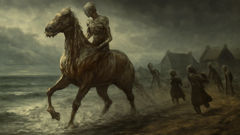
Earthen folk in Orkney learned to tell time by ale and tide, by the seasons and by stories of what happened when the rules were ignored. When kelp harvests were mismanaged or when cattle were left to stray on newly burned peat, the islanders said the sea took note. The Nuckelavee, some old crofters insisted, was the sea’s accountant: it tallied offenses and answered with a presence that smelled like brine and death. That notion composted into warning: do not burn peat on the wrong night; do not let boats drift; keep the seal of the croft intact. When a plague took hold of a village, when barley failed to stand, oral tradition found a shape to blame. The Nuckelavee’s breath wilting crops was a vivid, terrifying way to name crop blight.
Stories from the late medieval period through the 18th century—fragmentary, second-hand, and full of the folkloric mind’s neat exaggerations—describe encounters that read like weather reports gone wrong. A boy alone on the shore sees a horse “naked with flesh hanging like a butcher’s cloth,” and runs to the fold. A fishing crew notices foam on the sea and a smell that makes a dog vomit; they retreat with their catch unsold. The Nuckelavee enters these accounts not as a moral parable alone, but as an explanation for climate and epidemiological misfortune in pre-scientific terms. To accuse a demon was also to hold a community’s attention on certain practices. It was easier to say an unholy beast had ridden through a field than to admit one hadn’t planted well or had traded too greedily with a passing trader who brought tainted grain.
Within those stories there are patterns that hint at real pressures: a warm, damp summer followed by a blight of mildew in barley; an encroaching sea stripping salt into low fields; a parasite creeping across sheep flanks. The Nuckelavee, as a myth, maps those pressures onto a single, terrifying figure. That mapping offered psychological utility. If you could create a face for disease and blame the beast for the visible ruin, you also bound the community together: they could pool labor, they could enact rituals to keep the sea’s anger at bay, they could remember the code of the croft. Yet the myth is more than an instrument of social control. The imagery—the exposed musculature, the steam from nostrils that turned green barley to brittle husks—gives the myth a biological plausibility to pre-modern observers. Fleshless forms are the stuff of fever-dreams and nightmare fevers; the Nuckelavee’s nakedness resonated with people who saw rotting animals and human disease as a stripping away of the protective outer layer of life. Its amphibious origin—emerging from sea and peat—also made it liminal, neither wholly maritime nor purely terrestrial, and thus capable of threatening harvests and flocks with equal appetite.
By the 18th and 19th centuries, antiquarians collected accounts, noting the ways the Nuckelavee had been yoked to notions of sin and taboo: those who broke oaths, those who spilled blood on sacred ground, those who desecrated cairns were apt to be pointed at in rumor when misfortune followed. Conversely, some tales celebrate the cunning of a crofter or the sober cunning of a minister who outwitted the beast by following precise rites—locking gates at night, leaving salted oat cakes at field corners, or guiding the Nuckelavee back to its inlet with the noise of clinking metals. These are not simply superstitions; they are strategies—psychological salves and social rituals that mediated fear.
So, the Nuckelavee teaches us two things about Orkney: first, that the islands’ economy and survival depended on rituals and rules finely tuned to a harsh environment; second, that myth can be a practical technology for resilience. The beast’s cruelty and grotesque form codify the hazards of living where land and sea are constantly negotiating ownership. When the story says the Nuckelavee’s breath withers barley, it is naming an ecological event; when the same story tells of a child stolen by a water-spirit, it is mapping the pattern of accidental drownings. Oral tradition stitched these patterns into a living object—the demon—so communities could hold fast under pressure and pass efficient, memorable warnings from one generation to the next.
Image interlude: An old engraving-style scene shows a skinned horse galloping along a rocky shore, a fused rider straining toward a croft as villagers retreat. The waves curl like black fingers; the sky is the color of iron. This image sits in the oral record as well as in scholarly notes—an evocative anchor where the very sight of the beast in a crooked line of hoofprints fills a field of memory with caution.
Beyond utility, there is art in the fear. Poets and storytellers in Orkney have rendered the Nuckelavee in different cadences: as a cosmic punishment, as a lonely thing bound by old bargains, as an echo of Viking raiders whose sea-born cruelty became mythicized. Seen through layers of retelling, the Nuckelavee becomes both a local monster and a regional variant of a pan-Scandinavian corpus of water-demons. Its endurance owes as much to its use-value as to the terrible visual it provides: a horse stripped to sinew is unforgettable.
To stand on an Orkney cliff and look out toward the Atlantic is to be in contact with a climate that makes myths sensible. Wind and salt act on crops and flesh; peat fires smolder for weeks and release fumes that carry microbes. When heads of barley collapse in the field and animals sicken, it is easy—humanly easy—to look for a hand, a face, something to oppose. The Nuckelavee is that opposing face. It is the island’s monstrous ledger, an accounting of what happens when rules are broken and when nature answers back with a force that ancient tongues could only name by stitching a horse and its rider into an essence of ruin.
Anatomy of a Terror: Flesh, Breath, and the Science of Fear
There is a particular cruelty to monsters that refuse to be neatly symbolic. The Nuckelavee’s horror is anatomical; it is the raw exposure of systems we normally do not see. In imagining a horse without skin, the myth forces observers to confront muscle, tendon, and black blood. In a culture where tanning, butchery, and the sight of wintered sheep are routine, such a vision is both plausible and irrevocable—plausible because animal carcasses and disease-scarred livestock are visible facts, irrevocable because the image lodges in memory and is difficult to dislodge by argument.
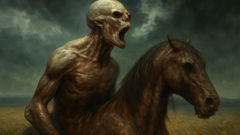
Think of the mouth and breath. In many accounts, it is not hooves or a flailed rider that devastate fields; it is the demon’s exhalation. Breath in folklore often names fermentation, disease, and miasma—the concept that noxious air brings illness. When barley falls overnight and children develop fevers, the pre-modern mind described the proximate agent as invisible air. To attach a smell and a gust to that air—an odor like rotting seaweed and a hot, oily steam—personifies an otherwise invisible threat. In period testimony, witnesses described the Nuckelavee’s exhalation as destructive with thermal intensity; they spoke of plants collapsing, of sheep frothing at the mouth. It reads like an attempt to put a literal face on what epidemiology would later explain as airborne contagion or plant blight.
Beyond smell, the Nuckelavee’s physiology suggests a symbolic catalogue: the fusion of rider and steed resists the separation between man and environment. That fused spine is an image of merged culpability; the rider is not separate from the horse, just as some human transgression is inseparable from environmental consequence. Agricultural communities understood this. Overgrazing, mismanaged peat burns, or saltwater inundation could look to an observer like an act of human stupidity—yet the myth frames harm as an active, punitive entity. The anatomy becomes a moral grammar: the exposed musculature says we are bare to the consequences; the steaming breath says consequence is immediate; the rider’s fused form says human misdeed is entangled with animal and ecosystem.
The Nuckelavee’s connection to seasons and pathogens is no accident. Fungal blights and rusts that wither cereal crops can proceed rapidly under damp, warm conditions—conditions not unusual in low-lying Orkney fields after an erratic summer. The smell reported by villagers—an oily, sea-sick reek—could be the sensory language of early fermentation or rot; the steam could be the heat of decomposition amplified by the damp cold of peat smoke. Early modern English and Scots describe miasmas with metaphors of breath and scent because they lacked germ theory’s instruments. The Nuckelavee thus becomes a cultural hypothesis, a narrative placeholder that accounts for what people feel and smell before they can name the microorganism.
Another anatomical detail deserves attention: the creature’s eyes, often described as pits of fire or vacant hollows. Empty sockets in many cultures mark an absence of soul or the presence of an unnatural hunger. In the Nuckelavee, they signify an entity driven by appetite rather than reason—a force that consumes crops and spreads illness without motive beyond hunger. That lack of motive is chilling; it removes the possibility of negotiation. Where many water-folk stories allow bargains—sacrifice a ring, leave a coin—the Nuckelavee promises no such bargaining. Its fused rider is not a malicious trickster who can be bribed; it is a catastrophe that arrives, walks, and moves on.
This aspect makes it especially terrifying to islanders who cannot simply flee the geography. The Nuckelavee does not hide in a far gorge; it rides across commons and peat, and its route is the settlement’s route. Because island living demands proximity to both sea and field, the mythology of a being that traverses both is especially potent. Where a mainland village might imagine a demon in a wood, Orkney’s devil walks the narrow isthmus between harvest and tide. The demon’s anatomized terror dictates new practicalities: they kept cattle under cover, salted seed before storage, and marked threshold rituals in hope of deterrence.
Consider ritual as applied anatomy. Salt, for instance, appears in many accounts as a barrier. Salt’s preservative properties were empirically known; its use was both symbolic and practical. If a story said that a salty circle kept the Nuckelavee at bay, that tale reinforced an agrarian rule: preserve grain, salt, and cure meat. Another darkly poetic countermeasure was the burning of tar-rich driftwood and peat to create choking smoke. Smoke confused smell and masked fields from the beast’s gusts; whether it worked or not, the community’s coordinated labor in such a rite was itself a bulwark against despair.
The modern reader might be tempted to demythologize—replace demon with fungus, breath with aerosolized pathogen, nakedness with visible lesions. Such translation is useful, but it flattens the story’s narrative power. The Nuckelavee is not merely a pre-scientific error; it is an imaginative synthesis that compresses environmental observation into a memorable organism. Its anatomy teaches vigilance: muscle and sinew speak of lived experience with animals and butchers; breath maps disease vectors onto sensory reality; fusion of rider and steed dramatizes the inextricability of human choices and ecological outcomes.
Finally, fear has its own micro-economy. A name like Nuckelavee trades for attention, for labor, and for caution. When the child in a tale runs to a crofter and says the beast rode through the barley, the village moves. That movement—closing gates, burning peat in a ring, carrying salt to folds—interrupts pathways through which blight or contagion might spread. In this way, the anatomy of terror becomes a functional instrument. The beast, with its raw muscles and alien breath, is a cultural technology: memorable, enforceable, and morbidly effective.
Encounters, Rituals, and the Long Shadow of the Beast
Stories of the Nuckelavee’s encounters read like a ledger of survival practices dressed in the outrageous. One frequent motif is the child who sees the beast on an evening walk and tells an elder. The narrative is seldom about the child alone; it is about how the community responds. In one account, an old woman answers with a spare set of instructions: draw a ring of seaweed and salt, set three peat fires at equal intervals, move the cattle to the hollow by the church, and leave a loaf and a pinch of grain at the field’s edge. These actions—practical, symbolic, and communal—reassert a sense of agency in the face of a terrifying unknown.
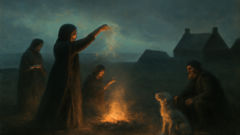
Rituals vary across the isles but tend to cluster around a few practical elements. Salt as boundary marks a hygienic habit reframed as ceremonial. Fires produce smoke that masks scent and produces a physical barrier to insect vectors and rot. Noise—clanging pots and shouting—keeps crowds alert and scares wild predators, and may have deterred predators that spread disease. Even the seemingly superstitious practice of leaving food offerings at field edges had secondary benefits: scattering food might distract scavengers that would otherwise feed on diseased carcasses and spread pathogens.
There are also tales of cunning locals outwitting the beast. A fisherman, in one recital, harnessed a pair of plough horses with raw hides and led them around the croft until dawn, confusing the Nuckelavee with the smell of ordinary livestock. Another story tells of a minister who walked the parish at dusk and recited scripture at thresholds, not because scripture manifests power over demons but because the act of walking the parish and checking thresholds increased surveillance and reduced the chance that early signs of disease or spoilage would go unnoticed. The moral force of ritual was as much about accountability as it was about faith.
More unsettling are accounts where the Nuckelavee is less a punisher than an echo of human cruelty. In some narratives, the beast appears near scenes of injustice—when a landlord illegally commandeers a crofter’s patch of land, when a trader sells tainted grain, when a boat is carelessly scuttled. The creature becomes an indictment of social breaches that corrode the fragile reciprocity needed on an island. Its appearance near wrongful acts suggests the myth also served as a folk form of justice: rumor and fear could force restitution, social shame could deter exploiters, and collective vigilance could be restored.
There are also quieter stories—those of watchers, people who kept vigils for the beast. Old sea-women and peat-cutters, who spent long hours in marginal places, often reported intermittent sightings: hoofprints filled with salt, a shimmer over a pack of kelp, a faint hiss in the door crack. These reports were dismissed by some antiquarians as superstition, but viewed in context, they are testimony to people whose daily habits made them more likely to notice early signs of spoilage, of salt seep, of the shifting of tides that would raise water tables and ruin crops. Their language of demons is an embodied form of observation.
Legend also preserves stories of negotiated boundaries. In one version, villagers lure the Nuckelavee back to the sea by piling the coast with the scent of salted fish and burnt peat, leaving a trail the demon cannot resist. The mythic logic here is clear: if the creature is bound to the liminal seam between sea and land, then reorienting that seam with a stronger odor or rhythm of fire can redirect the threat. The technique is a kind of proto-environmental management, a practice of altering micro-environments to protect harvestable spaces.
Over time, however, cultural shifts changed how people related to these rituals. Industrialization, the growth of scientific agriculture, and increasing literacy reduced the Nuckelavee’s persuasive power. Where once a seasonal rite could marshal half a village to stand watch, modern interventions—drainage schemes, crop rotation, veterinary care—offer concrete defenses. Yet the Nuckelavee retains a symbolic charge. Even today, on Orkney visits and in local storytelling, the beast is invoked as a cautionary emblem: heed the sea, respect place, remember that disruptions to ecology and community have consequences. Such invocations have a contemporary resonance: in times of climate instability and zoonotic risk, the old story rings like a parable about hubris and neglect.
The demon’s presence in literature and tourism complicates things. On the one hand, commodifying the Nuckelavee—souvenir postcards, guided ghost tours—risks trivializing a story that once encoded survival habits. On the other hand, retelling preserves the details of custom and language. The important balance is to treat the myth not as mere fright but as ethnographic record: it preserves how communities framed hazards and taught mutual obligations. Educators can therefore use the Nuckelavee as an entry point to discuss historical ecology, the importance of maintaining croft systems, and how human behaviors influence disease spread among animals and crops.
Finally, encounters with the Nuckelavee leave a psychological residue. The islander who grows up with the story learns a certain modesty toward the sea and weather—an awareness that the world can produce consequences beyond human control. That humility, embodied in ritual and story, has a pragmatic value: it promotes preparedness, cooperation, and respect. In a very modern sense, the Nuckelavee is a cultural technology for risk communication—folktale as early public health messaging, as early environmental policy disguised as myth. In that light, the beast’s long shadow is less monstrous than instructive: a community’s way of naming and thereby managing danger.
Conclusion
To end a tale of the Nuckelavee is to acknowledge both loss and persistence. The image of a skinned horse fused to a rider will always startle; it offers a ready face for the sudden, the inexplicable, and the devastating—whether that devastation is the result of blight, contagion, or human greed. But the myth’s real achievement is less its horror than its utility. It teaches through terror, translating ecological and social hazards into memorable ritual. It preserves practices that helped communities survive: salt and smoke, noise and watchfulness, the sealing of thresholds and the sharing of labor. Even as scientific understanding has replaced supernatural explanation, the Nuckelavee remains a caution about how we name and respond to risk. In an era when climate change reshapes coastlines and zoonoses remind us that human and animal health are entwined, the old Orcadian dread contains a blunt lesson: to live well on the margin of sea and soil demands humility, attention, and collective action. The demon’s breath, whether read as miasma or metaphor, calls us to notice what we might otherwise take for granted—the integrity of seeds we sow, the care we give animals, the pacts we make with our neighbors and our place. Myths like the Nuckelavee are not simply relics of a superstitious past. They are repositories of local wisdom, vivid moral mirrors that reflect how communities learned to stay alive. If the beast persists in tales and on postcards, let it be as a reminder, a strange guardian of old practices, that tells us: tend the land, respect the sea, and listen when the wind carries a warning.

